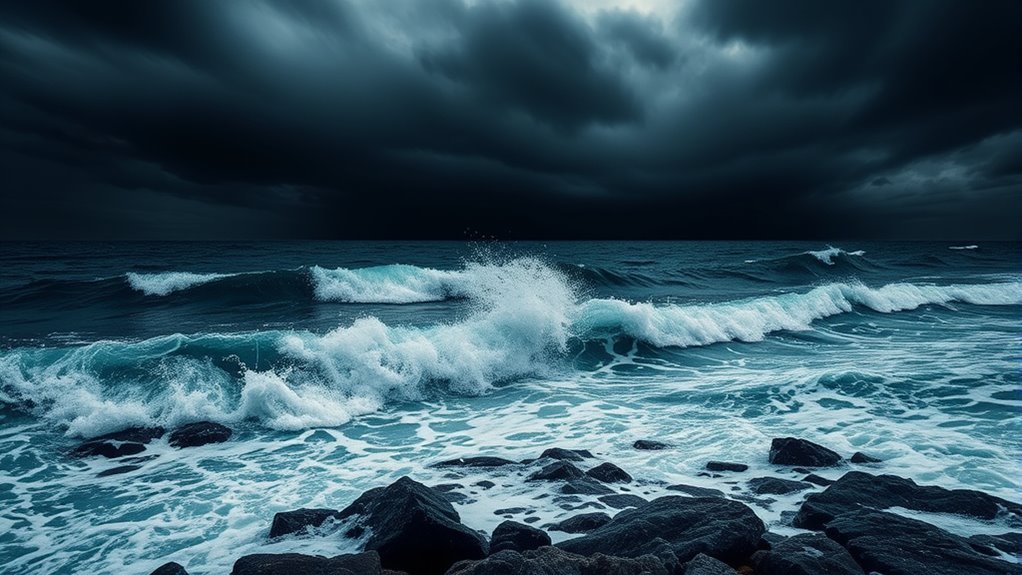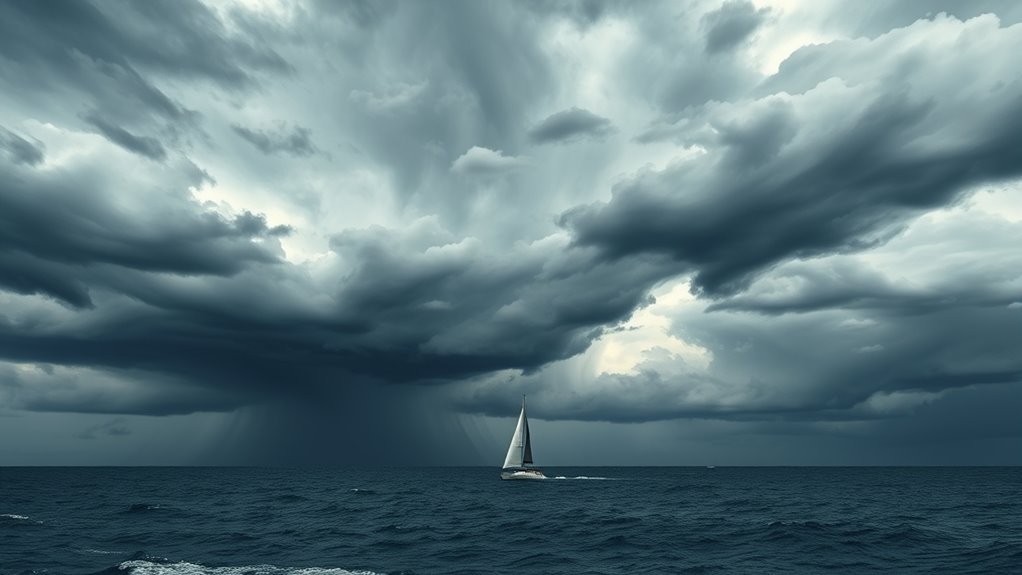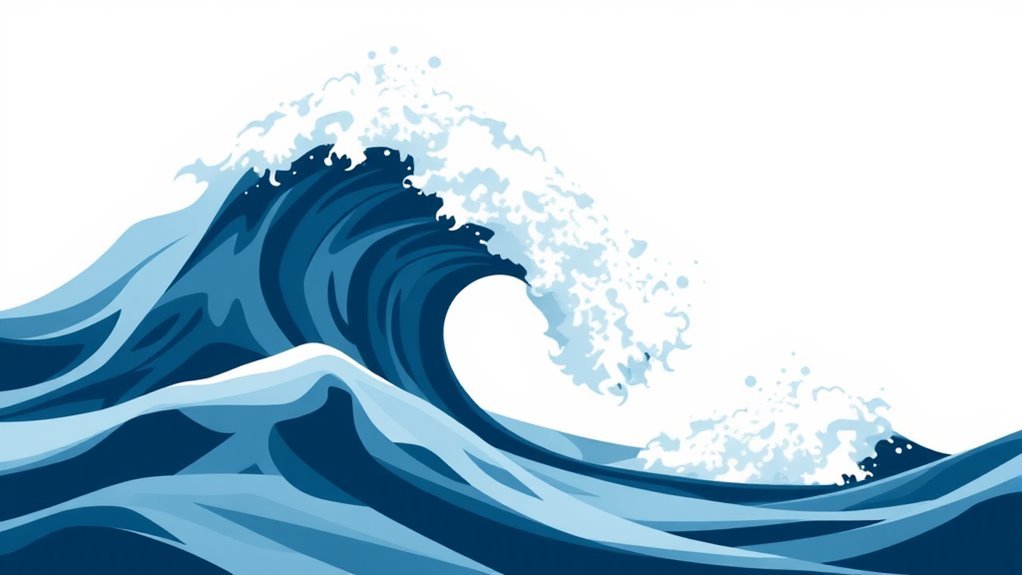Squalls are sudden bursts of intense wind, often accompanied by precipitation like rain, snow, or hail. They arise from steep temperature gradients and the interaction of warm, moist air with cold fronts. Various types include snow squalls and thunderstorm squalls, each posing unique risks. Their effects can disrupt daily life, lead to flooding, and damage infrastructure. Understanding squalls is essential for public safety, and there is much more to investigate about their characteristics and impacts.
Main Points
- Squalls are sudden bursts of intense wind and precipitation, lasting minutes to a few hours, causing significant weather changes and hazards.
- They develop due to steep temperature gradients, warm air rising over cooler air, and interactions between cold fronts and moist air masses.
- Types of squalls include snow squalls, thunderstorm squalls, and tropical system squalls, each presenting unique risks and challenges.
- Squalls can lead to flash flooding, infrastructure damage, and disruption of daily life, highlighting the importance of timely weather warnings.
- Monitoring tools like Doppler radar, satellite imagery, and weather stations are essential for tracking squalls and ensuring public safety.
Understanding Squalls: Definition and Characteristics
Squalls are sudden, intense bursts of wind often accompanied by rain or other forms of precipitation. Typically lasting for a brief period, they can generate notable changes in weather conditions. Squalls are defined by their abrupt onset, often catching individuals unprepared. The wind speed during a squall can increase dramatically, sometimes reaching gale force, which poses hazards to both land and sea. The accompanying precipitation may vary, including heavy rain, snow, or hail, depending on the environmental conditions.
These weather phenomena can occur in various settings, such as frontal boundaries or near thunderstorms. While squalls can be localized, their impacts can be widespread, affecting travel and outdoor activities.
Understanding the nature of squalls is essential for safety, as their rapid development can lead to dangerous situations. Recognizing the signs of an impending squall can aid in preparedness and response efforts, ensuring individuals can take necessary precautions.
The Causes of Squalls: Meteorological Factors

While various meteorological factors contribute to the formation of squalls, one of the primary triggers is the presence of steep temperature gradients in the atmosphere. These gradients create instability, as warm air rises rapidly over cooler air. This upward motion can lead to the development of convective cells, which are vital for squall formation.
Additionally, the interaction of different air masses, such as a cold front colliding with a warm, moist air mass, often intensifies squall conditions. Changes in wind direction and speed, known as wind shear, can also play a notable role, enhancing the vertical motion needed for squall development.
Moisture availability is another essential factor; when humid air is forced upward, it cools and condenses, resulting in precipitation and turbulence characteristic of squalls. Understanding these meteorological factors is fundamental for predicting squall events and their potential impacts on weather conditions.
Types of Squalls: From Snow to Thunderstorms
Meteorologists classify squalls into several distinct types, each defined by unique weather phenomena. One common type is the snow squall, defined by brief, intense snowfall that can greatly reduce visibility and create hazardous road conditions. These events often occur in winter and can develop rapidly, catching motorists off guard.
Another type is the thunderstorm squall, which involves a sudden onset of heavy rain, strong winds, and thunder. These squalls can lead to flash flooding and severe weather alerts due to their intensity.
Additionally, there are squalls associated with tropical systems, such as hurricanes, where strong winds and heavy rain occur in short bursts, impacting coastal areas greatly.
Each type of squall poses different risks and challenges, making it essential for meteorologists and the public to understand their traits for effective preparedness and response.
The Life Cycle of a Squall: Formation to Dissipation

Understanding the various types of squalls highlights the significance of examining their life cycle, which includes formation, development, and dissipation.
The formation of a squall typically occurs when a cold front rapidly advances into a warm, moist air mass, leading to instability. As the squall develops, intense winds and precipitation can arise, often accompanied by thunder and lightning.
Key stages in the squall life cycle include:
- Warm air rise: Warm air is forced upward, cooling and condensing.
- Thunderstorm development: Strong updrafts create thunderstorms.
- Wind shear: Changes in wind speed and direction improve turbulence.
- Precipitation: Heavy rain or snow begins to fall.
- Dissipation: The system weakens as the temperature equalizes and moisture decreases.
Understanding these stages is vital for predicting squall behavior and potential impacts on the environment.
The Impact of Squalls on Weather Patterns
Squalls considerably affect weather patterns by creating atmospheric instability that can lead to sudden changes in conditions.
Their presence often alters precipitation rates, resulting in intense rainfall over short periods.
Additionally, squalls influence wind patterns, which can have broader consequences for storm development and local climates.
Squalls and Atmospheric Instability
Although often brief, squalls can significantly disrupt weather patterns by introducing rapid changes in wind speed and direction.
These abrupt shifts can lead to atmospheric instability, affecting local meteorological conditions. The turbulence generated by squalls can have various consequences, including:
- Increased turbulence for aircraft during takeoff and landing.
- Heightened risk of flash flooding due to sudden downpours.
- Disruption of marine activities, impacting navigation and fishing.
- Altered temperature profiles, leading to unexpected weather changes.
- Potential damage to infrastructure, such as downed trees and power lines.
Understanding the role of squalls in atmospheric dynamics is essential for predicting their broader ramifications on weather systems.
Influence on Precipitation Rates
When squalls occur, they can dramatically alter precipitation rates, leading to sudden and intense rainfall events. These weather phenomena are defined by rapid changes in atmospheric conditions, including shifts in temperature and humidity, which can improve convective activity.
As squalls develop, they often trigger localized thunderstorms that produce heavy downpours over short durations. This intense rainfall can result in flash flooding, particularly in urban areas with poor drainage systems.
Furthermore, the sudden nature of squall-induced precipitation can disrupt agricultural practices, impacting crop yields and soil health. Understanding the influence of squalls on precipitation is essential for weather forecasting and disaster preparedness, enabling communities to better respond to the challenges posed by these abrupt weather changes.
Impact on Wind Patterns
The sudden and intense rainfall associated with squalls often coincides with considerable alterations in wind patterns.
These changes can greatly affect local meteorological conditions and lead to various impacts, including:
- Sudden wind shifts that can disrupt navigation and aviation.
- Increased wind speed, which may lead to hazardous situations for small vessels and aircraft.
- Formation of gust fronts, creating turbulence and further complicating weather systems.
- Development of localized downdrafts, which can boost storm intensity and affect nearby areas.
- Influence on temperature variations, as winds shift from cooler to warmer air masses or vice versa.
Understanding these impacts is essential for improving weather forecasting and safety measures in affected regions.
Safety Precautions During Squalls
Squalls can pose considerable risks to those caught in their path, making it essential to adopt proper safety precautions. Individuals should stay informed about weather conditions and seek shelter indoors when squall warnings are issued.
It is advisable to avoid outdoor activities, particularly water-related sports, as squalls can create sudden and dangerous changes in wind and water conditions.
For those in vehicles, it is critical to slow down and, if possible, pull over to a safe location until conditions improve. Staying away from windows can help protect against flying debris.
In coastal areas, mariners should secure vessels and avoid setting out during squall warnings.
Preparation is key; having an emergency kit with essentials can be priceless.
Finally, it is imperative to remain calm and avoid panic, as this can enhance clearer decision-making during such intense weather events.
Monitoring and Predicting Squalls: Tools and Techniques
While severe weather can be unpredictable, various tools and techniques have been developed to monitor and predict squalls effectively. Meteorologists utilize advanced technology and methodologies to provide timely warnings and improve public safety.
Key tools and techniques include:
- Doppler Radar: Tracks precipitation and wind patterns, helping to identify squall lines.
- Satellite Imagery: Provides a broader view of cloud formations and storm development.
- Weather Buoys: Collects data on atmospheric and oceanic conditions, offering perspectives into storm behavior.
- Numerical Weather Prediction Models: Uses complex algorithms to simulate weather patterns and forecast squalls.
- Weather Stations: Ground-based sensors measure temperature, humidity, and wind speed in real-time.
These methods allow meteorologists to make informed predictions, enhancing response strategies and minimizing the impacts of squalls on communities.
Common Questions
How Do Squalls Differ From Regular Storms?
Squalls differ from regular storms primarily in their sudden onset and intensity. They typically feature abrupt wind shifts and heavy precipitation, while regular storms may develop more gradually and exhibit a broader range of atmospheric conditions.
Can Squalls Occur in Tropical Regions?
Squalls can indeed occur in tropical regions, defined by sudden, intense bursts of wind and rain. These weather phenomena often arise from localized convective systems, contributing to the dynamic weather patterns typical of such climates.
What Historical Events Were Caused by Squalls?
Historical events linked to squalls include shipwrecks during maritime exploration, devastating agricultural losses in coastal communities, and severe disruptions in air travel. Such incidents often highlight the unpredictable nature of weather-related phenomena affecting human activities.
Are Squalls More Common in Certain Seasons?
Squalls are indeed more common in certain seasons, particularly during spring and summer. Their occurrence is influenced by warmer temperatures and increased humidity, which create ideal conditions for the rapid development of these intense weather phenomena.
How Do Squalls Affect Marine Navigation?
Squalls considerably impact marine navigation by causing sudden changes in wind speed and direction. This can lead to hazardous conditions, challenging vessel control and increasing the risk of accidents, particularly for smaller boats and inexperienced sailors.

